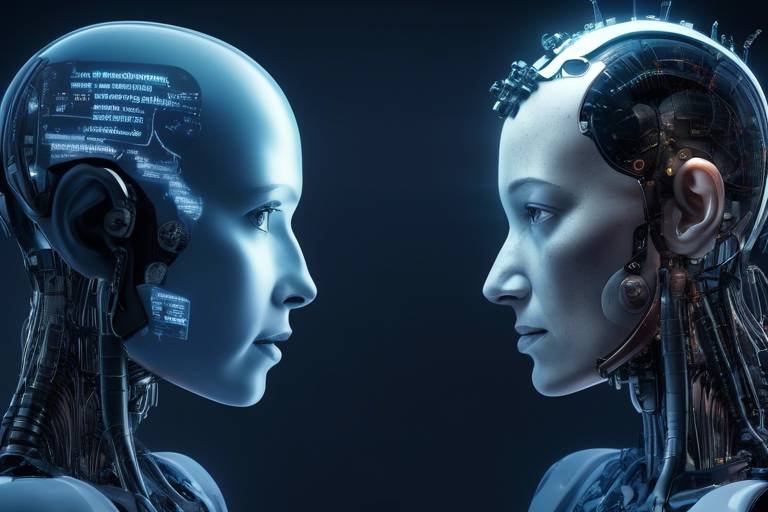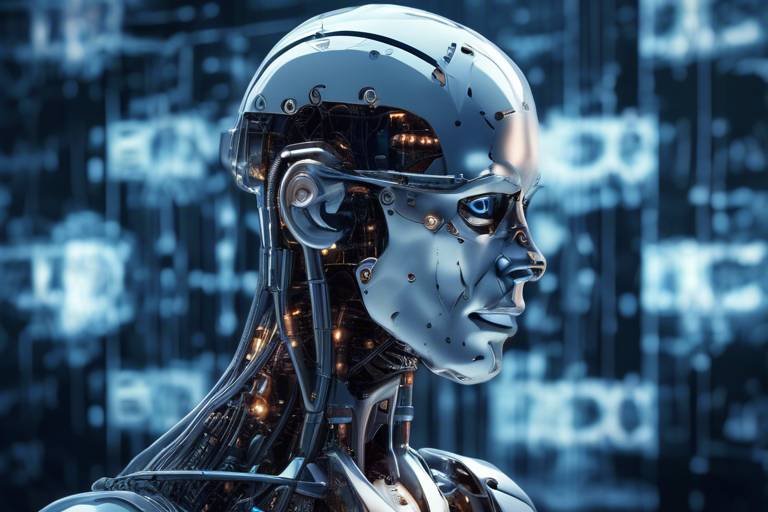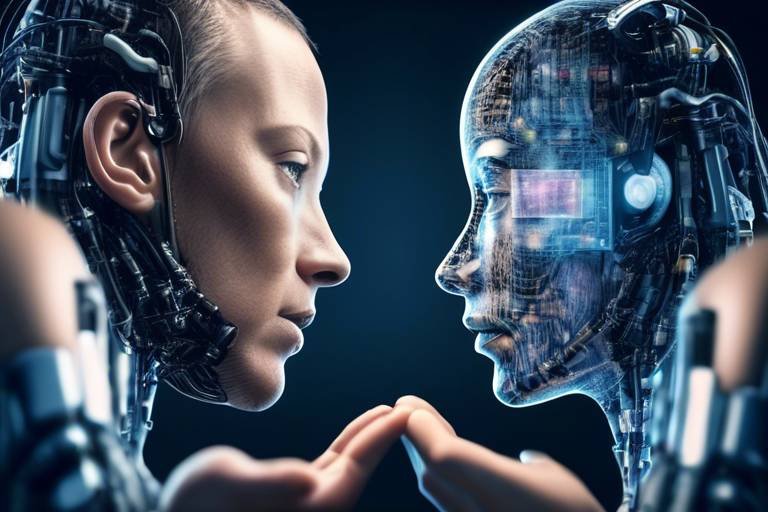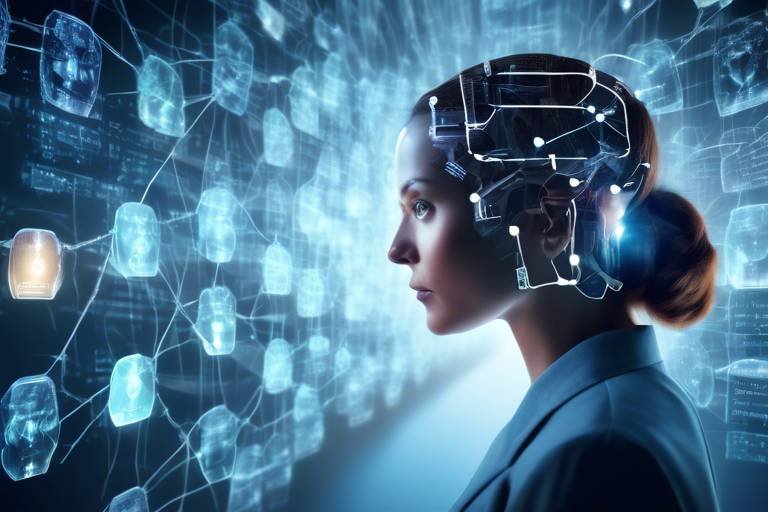The Age of AI-Assisted Collaboration: Are We Ready?
In today's fast-paced world, the integration of technology into our daily work lives has reached a tipping point, and artificial intelligence (AI) is at the forefront of this transformation. As we stand on the brink of a new era defined by AI-assisted collaboration, one question looms large: Are we ready? This article delves into the implications of AI in various fields, examining not only our readiness to embrace these changes but also the potential benefits and challenges that come with them. Imagine a workplace where mundane tasks are automated, decisions are backed by data-driven insights, and teams collaborate seamlessly across vast distances. Sounds appealing, right? But before we get too carried away, let’s explore the current landscape and what it means for the future of teamwork.
The surge of AI technology in collaborative environments is nothing short of remarkable. Recent studies indicate that organizations leveraging AI tools experience a significant boost in productivity—up to 40% in some cases! This is not just a passing trend; it's a fundamental shift in how we approach teamwork. From project management software to real-time communication tools, AI is being woven into the fabric of our collaborative efforts. In fact, a recent survey found that 70% of companies are investing in AI technologies to enhance their collaborative capabilities. As we explore this further, it's essential to recognize that while the potential is vast, so too are the challenges that lie ahead.
So, what exactly can AI bring to the table? The advantages of AI-assisted collaboration are numerous and transformative. For starters, AI enhances communication, making it easier for team members to connect and share ideas regardless of their physical location. Imagine being able to communicate in real-time with colleagues across the globe, all thanks to intelligent tools that understand your needs. Moreover, AI streamlines processes—think of it as a digital assistant that helps you prioritize tasks, manage deadlines, and keep everyone on track.
One of the most exciting developments in AI-assisted collaboration is the emergence of AI-driven communication tools. These tools are designed to facilitate real-time collaboration, effectively breaking down geographical barriers that once hindered teamwork. With features like automated translations and sentiment analysis, teams can engage more meaningfully than ever before. Picture a scenario where a team in New York can brainstorm ideas with colleagues in Tokyo, all while using a tool that translates their discussions in real-time. This level of interaction not only boosts creativity but also fosters a sense of unity among team members.
Gone are the days of tedious back-and-forth emails trying to find a suitable time for meetings. With AI, scheduling becomes a breeze. AI tools can analyze the calendars of all participants, suggesting optimal times for meetings based on availability. This automation not only saves time but also ensures that everyone is on the same page. Imagine the efficiency gained when teams can focus on what truly matters—collaboration and innovation—rather than getting bogged down in logistical challenges.
Another game-changer in AI-assisted collaboration is the enhancement of document sharing. AI tools can intelligently manage how documents are accessed and shared among team members. No more searching through endless folders; AI can categorize and suggest relevant documents based on the context of the conversation. This smart sharing feature not only streamlines workflows but also ensures that everyone has access to the information they need when they need it. Think of it as having a personal librarian who knows exactly what you need at any given moment!
Despite the myriad benefits, the road to AI-assisted collaboration is not without its hurdles. Resistance to change is a common challenge, as many team members may feel apprehensive about integrating AI into their workflows. Additionally, concerns surrounding data privacy and security can create roadblocks in adoption. It’s essential for organizations to address these issues head-on, fostering an environment where team members feel comfortable and informed about the technology they are using.
For organizations to successfully integrate AI into their collaborative efforts, proper preparation is key. This involves not only equipping team members with the necessary skills but also cultivating a culture that embraces AI technologies.
Training programs tailored to equip team members with the skills to use AI tools effectively are crucial. Organizations should invest in comprehensive training sessions that cover the basics of AI, its applications in collaboration, and best practices for using these tools. Resources like online courses, workshops, and hands-on training can make a significant difference in ensuring that everyone is on board and confident in using AI.
Creating a culture that supports AI integration is essential for success. Leadership plays a pivotal role in this process, as they must champion the use of AI and communicate its benefits clearly to the team. Open communication and feedback loops can help address concerns and foster acceptance among team members. After all, when everyone feels included in the conversation, the transition to AI-assisted collaboration becomes much smoother.
- What is AI-assisted collaboration?
AI-assisted collaboration refers to the use of artificial intelligence tools and technologies to enhance teamwork, streamline processes, and improve communication among team members.
- What are the benefits of using AI in teamwork?
Benefits include improved communication, automated scheduling, smart document sharing, and enhanced decision-making capabilities.
- What challenges might teams face when adopting AI?
Teams may encounter resistance to change, concerns about data privacy, and the need for training and skill development.
- How can organizations prepare for AI integration?
Organizations can prepare by providing training, fostering a supportive culture, and ensuring open communication about the benefits and challenges of AI.

The Rise of AI in Collaborative Work
Artificial Intelligence (AI) is not just a buzzword anymore; it's rapidly becoming a vital component of how teams collaborate across various industries. The integration of AI into collaborative work environments is reshaping the landscape of teamwork, enhancing productivity, and driving innovation. Imagine a world where mundane tasks are automated, allowing team members to focus on what truly matters—creative problem-solving and strategic planning. According to recent studies, organizations that have adopted AI technologies report a staggering 30% increase in productivity and a 25% improvement in team collaboration.
The current trends indicate that AI is being utilized in numerous ways. For instance, AI algorithms analyze data patterns to provide insights that inform decision-making. This means that teams can make more informed choices faster than ever before. Additionally, AI tools are being developed to enhance communication, streamline workflows, and foster a more interconnected work environment. A recent survey revealed that 70% of businesses are investing in AI-driven tools to improve collaboration, reflecting a significant shift in how teams operate.
One of the most exciting aspects of AI in collaborative work is its ability to break down geographical barriers. With the rise of remote work, teams are no longer confined to a single location. AI-powered platforms enable real-time collaboration, allowing team members from different parts of the world to work together seamlessly. Imagine a virtual meeting where everyone can share their screens, brainstorm ideas, and edit documents simultaneously, all thanks to AI-enhanced tools. This level of interaction not only boosts productivity but also fosters a sense of unity among team members, regardless of where they are located.
Furthermore, AI is being leveraged to analyze team dynamics and improve overall performance. By assessing how team members interact, AI tools can identify strengths and weaknesses within the group. This data can then be used to tailor training programs, ensuring that each member can contribute their best. For example, if an AI tool detects that communication is lagging between specific team members, it can suggest team-building exercises or workshops to enhance interaction.
As we look to the future, it's clear that the rise of AI in collaborative work is just beginning. The potential for innovation is immense, and organizations that embrace these technologies will likely find themselves ahead of the curve. However, it’s essential to remain aware of the challenges that come with this transition. As we delve deeper into the benefits and challenges of AI-assisted collaboration, it's crucial to understand how to prepare teams for this exciting new era.

Benefits of AI-Assisted Collaboration
In today’s fast-paced world, the integration of AI into collaborative workspaces is not just a trend; it’s a revolution. Imagine having a virtual assistant that can streamline your workflow, enhance communication, and even help you make better decisions. This is precisely what AI-assisted collaboration offers. The benefits are numerous and can significantly transform how teams operate, making them more efficient and effective.
One of the most significant advantages of AI-assisted collaboration is improved communication. With AI-driven tools, teams can communicate in real-time, regardless of their physical locations. For instance, platforms like Slack and Microsoft Teams have incorporated AI features that help summarize conversations, suggest responses, and even analyze sentiment. This means that team members can stay in sync without the usual misunderstandings that often arise in remote settings. Imagine being able to communicate as if you were sitting in the same room, even when you’re thousands of miles apart!
Moreover, AI can also assist in streamlining processes. Tasks that used to take hours can now be completed in mere minutes. For example, AI algorithms can analyze project data and provide insights on timelines, resource allocation, and potential bottlenecks. This allows teams to focus on what truly matters—creating high-quality work. According to recent studies, organizations that leverage AI for collaboration report a 30% increase in productivity compared to those that don’t.
Another compelling benefit of AI-assisted collaboration is enhanced decision-making. AI systems can analyze vast amounts of data in real-time, providing teams with actionable insights that would be impossible to gather manually. Imagine a scenario where your team is faced with a critical decision. With AI, you can quickly assess various outcomes based on historical data, market trends, and team feedback. This kind of informed decision-making can lead to better project outcomes and a more confident team.
As we delve deeper into the communication aspect, it's worth mentioning specific AI-driven tools that are making waves in the collaborative landscape. Tools like Zoom and Google Meet have integrated AI features that provide real-time transcription and translation. This means that no matter where you are in the world, language barriers can be broken down, allowing for smoother interactions. Additionally, AI can analyze communication patterns to suggest optimal times for meetings, ensuring that everyone is on the same page.
One of the most tedious tasks in any collaborative environment is scheduling meetings. AI can take this burden off your shoulders. Imagine having a tool that knows your team's availability and can suggest the best times for everyone to meet. Tools like Calendly use AI algorithms to find optimal meeting times, eliminating the back-and-forth emails that often lead to frustration. This not only saves time but also ensures that meetings are held at times when all participants can contribute effectively.
AI also revolutionizes the way documents are shared and accessed. With features like smart tagging and automated version control, teams can collaborate on documents without the chaos of multiple versions floating around. Imagine a world where you never have to search through endless email chains to find the latest version of a document. AI makes this possible by organizing and prioritizing documents based on relevance and usage patterns, enhancing overall teamwork.
In summary, the benefits of AI-assisted collaboration are profound. From enhancing communication to streamlining processes and improving decision-making, AI is set to redefine how teams work together. As we move forward, it’s clear that embracing these technologies will be crucial for organizations looking to thrive in an increasingly competitive landscape.
- What is AI-assisted collaboration? AI-assisted collaboration refers to the use of artificial intelligence tools and technologies to enhance teamwork, improve communication, streamline processes, and facilitate better decision-making.
- How can AI improve communication in teams? AI can improve communication by providing real-time translation, summarizing conversations, and analyzing sentiment, which helps team members stay aligned and understand each other better.
- What are some examples of AI tools for collaboration? Examples include Slack, Microsoft Teams, Zoom, and Google Meet, which incorporate AI features to enhance communication and streamline processes.
- Are there any challenges to implementing AI in teams? Yes, challenges can include resistance to change, data privacy concerns, and the need for proper training and support for team members.

Enhanced Communication Tools
In today's fast-paced world, effective communication is the lifeblood of any successful team. With the advent of AI-driven communication tools, teams can now collaborate in ways that were previously unimaginable. Imagine being able to connect with colleagues across the globe, sharing ideas and feedback in real-time, all while breaking down the barriers of time zones and geographical distances. AI is not just a tool; it’s a game-changer that enhances the way we interact and work together.
One of the most exciting aspects of these tools is their ability to facilitate real-time collaboration. For instance, platforms like Slack and Microsoft Teams leverage AI to provide smart suggestions and automate routine tasks, allowing team members to focus on what truly matters—creative problem-solving and innovation. These tools can analyze conversations, highlight important messages, and even summarize discussions for those who may have missed a meeting. This level of efficiency is akin to having a personal assistant who never sleeps, constantly ensuring everyone is on the same page.
Furthermore, AI can help tailor communication styles to fit individual team members. Think of it as having a customized communication coach that learns from your interactions and suggests the best ways to convey your message. This personalization not only enhances collaboration but also fosters a more inclusive environment where everyone feels heard and valued.
Another key feature of AI-enhanced communication tools is the integration of advanced analytics. Teams can gain insights into their communication patterns, identifying what works and what doesn’t. For example, a team might discover that certain times of day yield better responses to emails or that specific channels are more effective for particular types of communication. This data-driven approach allows teams to refine their strategies, ensuring that every message is impactful.
Moreover, the ability to automate mundane tasks cannot be overstated. AI can handle everything from scheduling meetings to sending reminders, freeing up valuable time for team members. Imagine a world where you no longer have to spend hours coordinating schedules; instead, AI can analyze everyone’s availability and suggest optimal meeting times. This not only boosts productivity but also reduces the stress associated with planning and organizing.
In summary, AI-driven communication tools are transforming the way teams collaborate. By enhancing real-time interactions, personalizing communication styles, providing valuable analytics, and automating tedious tasks, these tools are paving the way for a more connected and efficient work environment. As we move forward, embracing these technologies will be crucial for teams looking to stay competitive and innovative in an ever-evolving landscape.

Automated Meeting Scheduling
In today's fast-paced work environment, time is a precious commodity. The last thing anyone wants is to spend hours coordinating schedules for meetings. Thankfully, powered by AI is here to save the day! Imagine a world where you can simply input your availability, and the system does the rest—finding the best time for all participants without the back-and-forth emails that often lead to frustration. This technology not only enhances productivity but also allows team members to focus on what truly matters: their work.
AI-driven tools utilize advanced algorithms to analyze calendars and suggest optimal meeting times based on everyone’s availability. This eliminates the tedious task of manually checking schedules and reduces the chances of double-booking. For instance, when a team member is unavailable, the system can automatically propose alternative times, ensuring that everyone is on the same page. It's like having a personal assistant who knows everyone's schedule inside and out!
Moreover, automated meeting scheduling tools often come with integrated features that enhance the overall experience. For example, they can:
- Send automatic reminders to participants, reducing the likelihood of no-shows.
- Sync with various calendar applications, making it easy to keep everything organized.
- Provide analytics on meeting frequency and duration, helping teams assess their time management.
With these capabilities, teams can streamline their processes significantly. Instead of wasting time on logistical details, members can dedicate their energy to brainstorming ideas, solving problems, and driving projects forward. It's a game-changer in the realm of collaboration, making meetings more efficient and less of a burden.
However, it's essential to remember that while technology can facilitate scheduling, human interaction remains crucial. Automated systems should complement, not replace, the personal touch that comes with face-to-face conversations. After all, building relationships and fostering collaboration often happens outside of formal meetings.
In conclusion, automated meeting scheduling is a fantastic advancement in AI-assisted collaboration. By reducing the hassle of finding meeting times, teams can focus on what they do best, ultimately leading to improved productivity and a more harmonious work environment. As we continue to embrace these technologies, the future of teamwork looks not only efficient but also incredibly exciting!
- What is automated meeting scheduling? Automated meeting scheduling refers to the use of AI tools to find optimal meeting times based on participants' availability, eliminating the need for back-and-forth communication.
- How does it improve productivity? By streamlining the scheduling process, team members can focus their time and energy on their actual work rather than logistical details.
- Are there any downsides to using automated scheduling tools? While they can enhance efficiency, it's important to maintain human interaction and personal connections within teams.

Smart Document Sharing
In today's fast-paced work environment, the way we share documents has evolved dramatically, thanks to AI technologies. Gone are the days of cumbersome email attachments and endless back-and-forth exchanges. With smart document sharing, teams can collaborate seamlessly, making the entire process not only easier but also more efficient. Imagine walking into a virtual workspace where documents are not just files, but dynamic entities that adapt to your team's needs in real-time. That’s the magic of AI!
One of the key features of smart document sharing is its ability to provide real-time collaboration. This means that multiple team members can access and edit a document simultaneously, regardless of their geographical locations. Picture this: you're in New York, your colleague is in London, and another team member is working from Tokyo. With AI-enhanced tools, all of you can work on the same project document at the same time, seeing each other's changes instantly. This not only speeds up the workflow but also fosters a sense of teamwork and unity among members.
Moreover, smart document sharing platforms often come equipped with advanced version control features. This ensures that everyone is on the same page (literally!) and that no one accidentally overwrites important information. If someone makes a mistake or changes something that needs to be reverted, AI can help track changes and restore previous versions with just a few clicks. This is particularly beneficial in collaborative projects where multiple inputs can lead to confusion. With AI managing these changes, teams can focus more on creativity and less on the nitty-gritty of document management.
Another fantastic aspect of AI-driven document sharing is its intelligent categorization and tagging capabilities. Imagine you’re looking for a specific report from last quarter. Instead of sifting through countless files, AI can quickly retrieve documents based on keywords or tags. This not only saves time but also reduces frustration, allowing teams to concentrate on their core tasks rather than hunting for files. Additionally, AI can suggest relevant documents based on the context of your current work, making it feel like you have a personal assistant at your fingertips.
However, it’s essential to recognize that while smart document sharing offers numerous advantages, it’s not without its challenges. Issues such as data security and access control must be addressed. Organizations need to ensure that sensitive information is protected and that only authorized personnel can access certain documents. This is where AI can also play a pivotal role, as it can help monitor access and alert users to any suspicious activities.
In conclusion, smart document sharing is revolutionizing the way teams collaborate. By leveraging AI technologies, organizations can enhance productivity, improve communication, and streamline workflows. As we move toward a more interconnected future, embracing these tools will be crucial for any team looking to stay competitive and efficient.
- What is smart document sharing?
Smart document sharing refers to the use of AI technologies to facilitate real-time collaboration on documents, allowing multiple users to access and edit files simultaneously. - How does AI improve document sharing?
AI enhances document sharing by providing features like real-time collaboration, version control, intelligent categorization, and tagging, making the process more efficient and user-friendly. - Are there security concerns with smart document sharing?
Yes, organizations must address data security and access control issues to protect sensitive information. AI can help monitor access and alert users to any suspicious activities.

Challenges of Implementing AI in Teams
As organizations rush to embrace the promise of AI-assisted collaboration, it's essential to acknowledge that the road to implementation is not without its hurdles. While the benefits of AI are enticing, teams often face significant challenges that can hinder the smooth integration of these technologies. Resistance to change is one of the most common barriers. Many team members may feel threatened by the introduction of AI, fearing that it could replace their jobs or disrupt established workflows. This reluctance can lead to a lack of engagement and enthusiasm, which is crucial for successful implementation.
Another concern revolves around data privacy. As AI tools often require access to sensitive information, team members may worry about how their data is used and whether it is adequately protected. This anxiety can create a culture of mistrust, making it difficult for teams to fully embrace AI technologies. Moreover, organizations must navigate the complex landscape of regulations and compliance issues related to data usage, which can further complicate the integration process.
Additionally, the technical challenges associated with AI implementation cannot be overlooked. Not all teams have access to the necessary infrastructure or technical expertise to deploy AI tools effectively. This gap can lead to frustration and inefficiencies, as teams may struggle to utilize the technology to its fullest potential. Furthermore, the rapid pace of AI development means that teams must continuously adapt and learn, which can be overwhelming for those already juggling multiple responsibilities.
To illustrate these challenges, consider the following table that summarizes the key obstacles faced by teams when implementing AI:
| Challenge | Description |
|---|---|
| Resistance to Change | Team members may feel threatened by AI, fearing job loss or disruption of workflows. |
| Data Privacy Concerns | Worries about how sensitive information is used and protected can create mistrust. |
| Technical Challenges | Lack of infrastructure or expertise can hinder effective deployment and use of AI tools. |
In conclusion, while the potential of AI in enhancing collaboration is vast, organizations must approach its implementation with caution. Addressing these challenges head-on is crucial for fostering an environment where teams can thrive with AI. By promoting open communication, providing adequate training, and ensuring data security, organizations can pave the way for a smoother transition into the age of AI-assisted collaboration.
- What are the main challenges of implementing AI in teams? The primary challenges include resistance to change, data privacy concerns, and technical difficulties.
- How can organizations overcome resistance to AI? Organizations can address resistance by promoting transparency, involving team members in the decision-making process, and providing education about AI benefits.
- Why is data privacy a concern with AI tools? AI tools often require access to sensitive data, which raises concerns about how that data is used and protected.
- What can be done to ensure successful AI integration? Providing adequate training, fostering a supportive culture, and addressing technical challenges are key steps to ensure successful integration.

Preparing Teams for AI Integration
As we stand on the brink of a technological revolution, the successful integration of AI into collaborative environments is becoming increasingly vital. It's not just about bringing in new tools; it’s about preparing our teams to embrace these changes wholeheartedly. Think of it like introducing a new member to your team—one who is incredibly knowledgeable and can help streamline your processes, but only if everyone is on board and ready to adapt. So, how do we prepare teams for this AI-driven future?
First and foremost, training and skill development are crucial. It’s essential to equip team members with the necessary skills to navigate AI tools effectively. Many organizations are now investing in comprehensive training programs that not only cover the technical aspects of AI but also focus on how these tools can enhance collaboration. For instance, workshops and online courses can be tailored to specific tools your team will use, ensuring everyone feels confident and competent. A recent study showed that teams who underwent structured training reported a 30% increase in productivity within the first few months of AI integration.
Moreover, it's important to foster a supportive culture around AI adoption. Change can be daunting, and resistance is natural. Leaders play a pivotal role in this phase. They need to communicate the benefits of AI clearly and consistently, showing how it can alleviate workloads and enhance creativity rather than replace human input. Open communication channels encourage team members to voice their concerns and suggestions, creating an environment where everyone feels included in the transition. This approach not only builds trust but also cultivates a sense of ownership among team members regarding the AI tools they will use.
To further assist in this transition, consider implementing a mentorship program. Pairing less experienced team members with those who are more adept at using AI tools can create a supportive learning environment. This way, the knowledge sharing is organic and fosters collaboration, allowing everyone to grow together. Additionally, regular feedback sessions can help identify areas where further training might be necessary, ensuring that no one is left behind.
As we prepare our teams for AI integration, it’s crucial to remember that this is not just a technological shift but a cultural one. By prioritizing training and fostering a supportive environment, we can ensure that our teams are not only ready for AI but are also excited about the possibilities it brings. The future of teamwork lies in our ability to adapt and grow alongside these intelligent systems, creating a synergy that enhances our collective potential.
- What is AI-assisted collaboration?
AI-assisted collaboration refers to the use of artificial intelligence tools and systems to enhance teamwork, streamline processes, and improve communication among team members.
- How can we train our team on AI tools?
Training can be conducted through workshops, online courses, and hands-on sessions where team members can practice using AI tools in real scenarios.
- What are the common challenges in adopting AI?
Common challenges include resistance to change, data privacy concerns, and the need for ongoing training and support.
- How can leadership support AI integration?
Leadership can support AI integration by communicating benefits clearly, fostering a culture of openness, and providing necessary resources and training.

Training and Skill Development
As we dive deeper into the realm of AI-assisted collaboration, one of the most critical aspects to consider is . It's not just about throwing new technology at teams and hoping for the best; it's about ensuring that everyone is equipped with the right tools and knowledge to leverage these advancements effectively. Imagine a ship setting sail without a skilled crew; it’s bound to face turbulent waters. Similarly, without proper training, teams may struggle to navigate the complexities of AI tools.
First things first, organizations need to recognize that AI integration is not a one-time event but an ongoing journey. This means developing a comprehensive training program that evolves alongside technology. A well-structured training program should include various elements:
- Workshops and Seminars: Regular workshops can provide hands-on experience with AI tools, allowing team members to learn in a supportive environment.
- Online Courses: Leveraging platforms that offer courses on AI and its applications can help team members learn at their own pace.
- Mentorship Programs: Pairing less experienced employees with AI-savvy mentors can foster knowledge sharing and practical learning.
Moreover, it’s essential to tailor training programs to meet the specific needs of different teams. For instance, a marketing team may require training focused on AI-driven analytics tools, while a project management team might benefit more from AI scheduling and resource allocation tools. By customizing the training content, organizations can ensure that each team member gains the skills that are most relevant to their roles.
Another crucial aspect of training is ensuring that team members feel comfortable with AI technologies. This involves addressing any fears or misconceptions they may have. Many people worry that AI will replace their jobs, but the reality is that AI is designed to enhance human capabilities, not replace them. By fostering an environment that encourages questions and open discussions about AI, organizations can help alleviate these concerns and promote a more positive attitude towards technology.
In addition to formal training, ongoing skill development is vital. This can be achieved through regular feedback sessions where team members can discuss challenges they face while using AI tools. By creating a feedback loop, organizations can continuously refine their training programs to better serve their teams. It’s like tuning a musical instrument; regular adjustments lead to a harmonious performance.
Finally, it’s important to measure the effectiveness of training initiatives. Organizations should track progress and assess the impact of AI tools on team performance. This could be done through surveys, performance metrics, and even informal check-ins. By evaluating the effectiveness of training programs, organizations can make informed decisions about future investments in skill development.
In summary, are fundamental components of successfully integrating AI into collaborative environments. By investing in comprehensive training programs, fostering a supportive culture, and continuously measuring progress, organizations can empower their teams to thrive in the age of AI-assisted collaboration.
Q1: What are some effective training methods for AI tools?
A1: Effective training methods include workshops, online courses, and mentorship programs tailored to the specific needs of different teams.
Q2: How can organizations address fears of AI replacing jobs?
A2: Organizations can address these fears by promoting open discussions about AI's role in enhancing human capabilities and providing reassurance through training.
Q3: Why is ongoing skill development important?
A3: Ongoing skill development ensures that team members stay updated on new AI tools and practices, allowing them to adapt to changes effectively.

Building a Supportive Culture
In the ever-evolving landscape of AI-assisted collaboration, one of the most critical elements for success lies in within teams. But what does it mean to foster such a culture? Imagine a garden where each plant is nurtured to grow; similarly, a supportive culture allows team members to thrive alongside AI technologies. It’s not just about implementing new tools; it’s about embracing a mindset that welcomes change and innovation.
Leadership plays a pivotal role in creating this environment. When leaders actively promote the use of AI and demonstrate its benefits, they set the tone for the entire team. Consider this: if a captain of a ship is enthusiastic about navigating new waters, the crew is more likely to feel excited about the journey. Leaders should communicate openly about the advantages of AI, share success stories, and encourage team members to voice their thoughts and concerns. This open dialogue fosters trust and reduces resistance to change.
Moreover, training and skill development are essential components of a supportive culture. Just as a musician practices to master their craft, team members need to be equipped with the right skills to utilize AI tools effectively. Offering workshops, online courses, and hands-on training sessions can empower individuals to feel confident in their abilities. When team members feel competent, they are more likely to embrace AI technologies rather than shy away from them.
Another vital aspect is recognizing and celebrating small victories. When teams achieve milestones—whether it’s successfully completing a project with the help of AI or simply mastering a new tool—celebrating these wins can significantly boost morale. It’s like throwing a party for a job well done; it brings everyone together and reinforces the idea that AI is a valuable ally in their collaborative efforts.
To further illustrate the impact of a supportive culture, let’s take a look at some key elements that contribute to its development:
| Element | Description |
|---|---|
| Open Communication | Encouraging team members to share their thoughts and feedback on AI tools fosters trust and collaboration. |
| Continuous Learning | Providing ongoing training and resources ensures that team members stay updated on AI advancements. |
| Recognition | Celebrating achievements motivates team members and reinforces the positive aspects of AI integration. |
| Leadership Support | Leaders who advocate for AI tools inspire confidence and encourage team members to embrace change. |
In conclusion, building a supportive culture for AI integration is not merely a checkbox on a to-do list; it’s an ongoing commitment that requires dedication, communication, and celebration. By nurturing an environment where team members feel valued and empowered, organizations can unlock the full potential of AI-assisted collaboration. Are we ready to cultivate this garden of innovation? The answer lies in our willingness to embrace change together.
- What is AI-assisted collaboration? AI-assisted collaboration refers to the use of artificial intelligence tools and technologies to enhance teamwork and communication among team members.
- How can leaders foster a supportive culture for AI? Leaders can foster a supportive culture by promoting open communication, providing training, and recognizing team achievements.
- Why is training important in AI integration? Training is crucial because it equips team members with the necessary skills to effectively use AI tools, reducing resistance and increasing confidence.
- What are some challenges in building a supportive culture? Challenges may include resistance to change, lack of understanding of AI tools, and insufficient communication from leadership.
Frequently Asked Questions
- What is AI-assisted collaboration?
AI-assisted collaboration refers to the use of artificial intelligence technologies to enhance teamwork and communication among team members. It includes tools that facilitate real-time collaboration, automate scheduling, and improve document sharing, making it easier for teams to work together efficiently, no matter where they are located.
- How can AI improve team communication?
AI can significantly boost team communication by providing tools that enable instant messaging, video conferencing, and automated language translation. These features help eliminate barriers caused by distance and language differences, ensuring that all team members can engage effectively and stay on the same page.
- What are the main benefits of using AI in collaborative work?
The primary benefits of AI in collaborative work include enhanced productivity, better decision-making, and streamlined processes. AI tools can analyze data quickly, provide insights, and automate routine tasks, allowing team members to focus on more strategic aspects of their projects.
- What challenges might teams face when integrating AI?
While AI brings many advantages, teams may encounter challenges such as resistance to change, concerns about data privacy, and the need for new skills. It's essential for organizations to address these issues through proper training and by fostering a supportive culture that embraces technology.
- How can teams prepare for AI integration?
To prepare for AI integration, teams should focus on training and skill development. Offering workshops, online courses, and hands-on practice with AI tools can help team members become comfortable and proficient in using these technologies. Additionally, building a culture of open communication and support from leadership is crucial for successful adoption.
- What types of training programs are effective for AI tools?
Effective training programs for AI tools often include a mix of online tutorials, interactive workshops, and real-world simulations. These formats allow team members to learn at their own pace while also providing opportunities for collaboration and feedback, ensuring a well-rounded understanding of the tools.
- Can AI replace human collaboration?
No, AI is not meant to replace human collaboration but to enhance it. While AI can automate certain tasks and provide valuable insights, the human element of teamwork—such as creativity, emotional intelligence, and personal connections—remains irreplaceable. AI serves as a tool to support and empower teams, not to take their place.



















